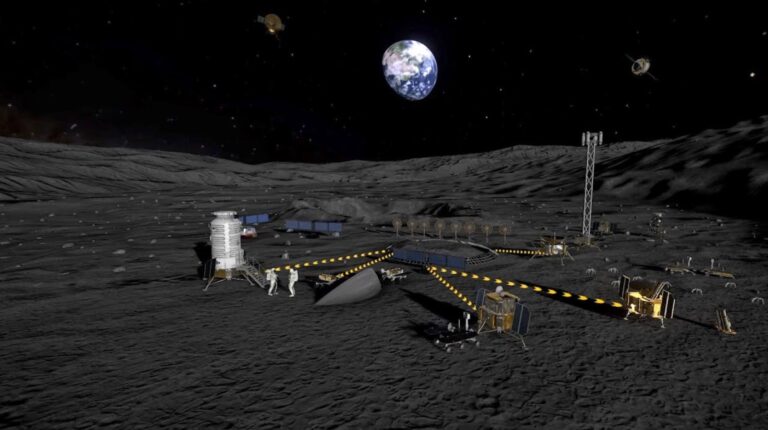HELSINKI — Serbia has signed an agreement to participate in the China-led International Lunar Research Station.
Earlier this week, the Serbian Ministry of Science, Technology Development and Innovation signed a memorandum of understanding with the China National Space Administration (CNSA) on cooperation on the International Lunar Research Station (ILRS).
This development was stated in a Chinese Ministry of Foreign Affairs document published on May 9th, which listed achievements following Chinese President Xi Jinping’s state visit to Serbia from May 7th to 8th. . CNSA has not yet issued its own statement on the matter.
In addition to the ILRS, the two leaders also signed a memorandum of understanding on cooperation in the areas of innovation in space exploration and peaceful uses.
The Chinese-led ILRS envisions building a permanent moon base in the 2030s. It will be constructed using super-heavy-lift launchers. China also aims to send astronauts to the moon by 2030.
It plans to launch a precursor mission in the 2020s. These include the Chang’e 7 and subsequent Chang’e 8 in-situ resource utilization technology test missions around 2026. Both multi-spacecraft missions will target the moon’s south pole. The Chang’e 6 sample return mission, currently in orbit around the moon, is nominally part of the planned landing in early June.
Chinese officials say ILRS has a number of scientific and engineering goals. These include lunar and earth science, astronomy, conducting experiments, and resource utilization. Others are said to include advancing technology development and laying the foundations for further lunar space exploration.
Russia said this week that it is developing a nuclear power plant for a joint lunar station, Reuters reported, citing the RIA news agency.
At this stage, it is unclear how Serbia will engage and contribute to the ILRS. China had previously announced its intention to create an ILRS Cooperation Organization (ILRSCO) to oversee and manage the project. Its establishment and subsequent meetings are likely to begin detailed planning of the involvement of Serbia and other parties in the project. However, this development is noteworthy for many reasons.
“I think this speaks to the interest in accessing the moon, and not only that, but in finding a partner, China, that effectively uses space as a form of soft power support.” said Commissioner Victoria Samson. said Director of Space Security and Stability at the Secure World Foundation. space news on mail.
“And while this agreement was made with China, we cannot overlook Serbia’s historical closeness with Russia and the increasingly authoritarian relationship between the Serbian president and President Putin. Therefore, by signing the ILRS, Serbia can gain more tangible benefits in its relations with China and at the same time reaffirm its ties with Russia.
“The more countries that sign on to either the Artemis Accords or the ILRS, the more countries that sign on to either the Artemis Accords or the ILRS, while exploration is still in its infancy, the more we understand how to conduct activities on the moon to avoid collisions and the more all stakeholders can We need to be clear about what we believe is responsible behavior in lunar space so that we can ensure long-term sustainable access to and around it,” Samson added.
Serbia becomes the 11th country to join the ILRS, following Nicaragua and Thailand in April. China and Russia officially announced the joint ILRS project in St. Petersburg, Russia in June 2021. Venezuela, Pakistan, Azerbaijan, Belarus, South Africa, and Egypt signed the agreement in 2023.
| LRS signer | type |
|---|---|
| China | Country |
| Russia | Country |
| Belarus | Country |
| Pakistan | Country |
| Azerbaijan | Country |
| Venezuela | Country |
| South Africa | Country |
| Egypt | Country |
| Nicaragua | Country |
| Serbia | Country |
| Asia Pacific Space Cooperation Organization (APSCO) | intergovernmental organization |
| nanoSPACE AG (Switzerland) | hard |
| International Lunar Observatory Association (ILOA, Hawaii) | organization |
| National Astronomical Research Institute of Thailand (NARIT) | research institute |
| University of Sharjah (UAE) | university |
| Adria Aerospace Association (A3) (Croatia) | organization |
| Astronomical Society of Colombia (ASASAC) | organization |
| Arabayev Kyrgyz State University (Kyrgyzstan) | university |
| PT Universal Satellite Indonesia (UniSat) | hard |
| Arab Astronomy and Space Sciences Union | organization |
The arrangement of countries that have signed the ILRS appears to indicate China’s broader focus on the Global South. China is also attracting many organizations, universities, and companies to join ILRS. This includes Croatia’s Adria Aerospace Association (A3).
The ILRS Memorandum is not the first bilateral space agreement between China and Serbia. The two countries signed a memorandum of understanding on space technology in 2020. The agreement aimed to fly the Serbian flag on the co-designed spacecraft. It also aims to strengthen cooperation in the development and use of space technology for various applications.
Serbia, located on Europe’s Balkan Peninsula, has a small space sector. Serbian universities and research institutes are involved in space science and related fields and also work on international projects. For example, the University of Belgrade is engaged in research in astrophysics, satellite engineering and remote sensing.
Serbia is neither a member nor an associate member of the European Space Agency (ESA), nor does it have a cooperation agreement with the agency. Hungary, which followed Serbia on a state visit by President Xi Jinping, is a full member of the ESA. It appears that no agreement regarding the ILRS was signed during that visit.

